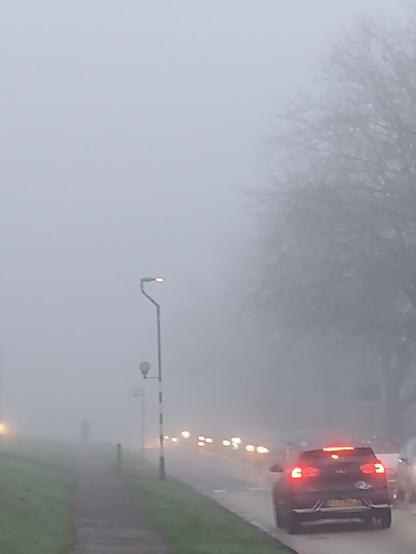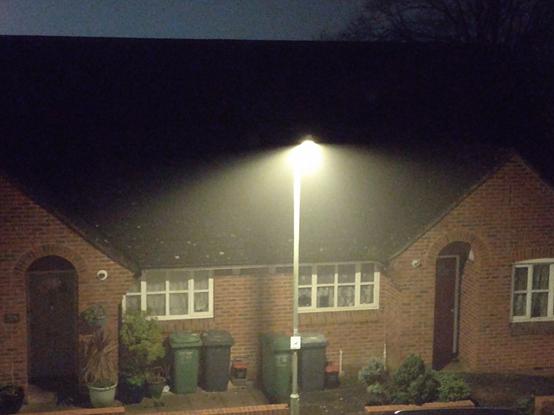#PhysicsFactlet
It's a foggy day here in Albion, so let's talk about light (multiple) scattering!
Fog is composed of micrometre sized water droplet that can scatter light. This has two main effects: some of the light that was supposed to reach your eyes don't (because it is scattered away), and some of the light that was not supposed to reach you gets scattered into your eyes.
The denser is the fog and the further an object is from you, the more likely light is to be scattered away before it reaches your eyes. The amount of unscattered light (i.e. the one your eyes can use to form a sharp image) goes down exponentially (Lambert-Beer law), so an object in the fog gets dimmer pretty quickly. On the other hand there is a chance that light that was never meant to reach you is now scattered into your eyes, but since it arrives from a largely random direction, mixed up with a lot of other scattered light, your brain perceived it as a white blur on top of everything else. And since far away object were already dim, this white halo can easily overpower them, so you can't see them anymore.
#EverydayPhysics
#PhysicsFactlet
Light propagates in a straight line (actually it is more complicated than that, but this is good enough for us here) and we see only the light that comes to our eyes. As a result you usually don't see the light going from its source to the objects it illuminates.
Unless it is misty, in which case light can scatter on the water droplets and you can "see" the light's path ("Tyndall effect").
This had #everydayphysics written all over it. What shape of pebble is best for skipping it across water? (and yes its experimental). #physics
https://physics.aps.org/articles/v17/s85?utm_campaign=weekly&utm_medium=email&utm_source=emailalert
We're getting better at gun #forensics for use in court cases. #everydayphysics #physics
https://pubs.aip.org/physicstoday/article/77/6/26/3294595/Firearms-forensics-is-becoming-more
Seems a tad cruel this turned up in my inbox when I just spent 40 minutes dismantling my #coffee grinder to unblock it. Mind you, I usually prefer my coffee hot. #acoustics #ultrasonic #physics #everydayphysics
https://www.unsw.edu.au/newsroom/news/2024/05/Ultrasonic_cold_brew_coffee_ready_under_three_minutes
The most important cooking question for a physicist, what second‐order differential equation should you use to grill a steak to perfection? #EverydayPhysics #cooking https://pubs.aip.org/physicstoday/article-lookup/doi/10.1063/1.882728
A glasshouse cafe with two sorts of cooling system. Pokok in Kuala Lumpur, Malaysia, is air conditioned but also, if you look carefully you can see a sprinkler on the roof of the cafe - pouring water on the roof which then evaporates to help the cooling.
#noticing #cafe #coffeescience #TakingFiveMinutesToNoticeThings #physics #EverydayPhysics
Why does the water come down wavy and not straight?
#waterfountain #watercurtain #everydayphysics #naturephotography
(5/5) “The advantage of a (#cheese)wire is that you can apply pressure only at the edge of the cut without all the extra friction & without squashing the cheese 🧀 so much that it becomes stiffer & harder to cut.
…Cutting cheese with a wire is a neat solution to the #physics problem of how to create a sharp, smooth cut in a resistant #proteinmesh.”
#HelenCzerski, #WSJ, #EverydayPhysics #CheeseScience #CheeseWire #CheeseCutter #Cheesy
😛
(3/3…no…4) “#Cheese with more #water 💧 or more #fat is generally softer, because those fillers space out the #protein matrix, reducing the number of #interconnections.
More mature cheese 🧀 is crumblier because its #proteinmatrix has broken down further.
A #cheddar can be somewhere in the middle, not too hard or too soft.
Varying the #proteinstructure can create almost any #texture.”
HelenCzerski, #WSJ, #EverydayPhysics
(2/2…no…3) The key to the #cheese’s 🧀 outward appearance is the #protein mesh, & the rest is window-dressing.
To make cheese, the #milkproteins are coagulated to form #curds, & these curds are chopped up & pressed to remove 💦 water.
Most #cheeses are aged for 2-24 months, & their structure changes as some of the proteins break down over time. The outcome can vary hugely depending on the number & strength of the bonds holding the #casein mesh together.”
HelenCzerski, #WSJ, #EverydayPhysics
(1/2) #Cheese🧀 science!
“All #cheeses are preserved #milk, but they can be squishy & almost liquid, brittle & crumbly or nearly rock-hard. Yet if you zoom in, their #molecules have the same basic structure.
Making cheese 🧀 is about creating a #spongelike structure out of the #milkprotein called #casein, essentially a mesh held together by #calcium. The sponge’s gaps are filled with #fatglobules & 💧 water.”
Another #coffee linked video from the “Gallery of Fluid Motion”.
Have you ever watched as droplets of coffee ‘bounce’ over the surface of your brewing pour over?
A known #physics phenomenon, these ‘drops’ are usually observed in the lab using silicone oil. A ‘how to’ video to (reproducibly) make them is linked to this toot. To do it with coffee instead, mix the coffee with a little bit of soap.
Happy holiday experimenting!
#everydayphysics #science #coffeephysics
https://gfm.aps.org/meetings/dfd-2022/6322d6d0199e4c2c0873f8df
The other day I experienced the audio #DopplerEffect of a stationary emergency vehicle siren as I #cycled past it. Everyone has experienced a speeding ambulance or police car with its siren going off and its changing pitch as it goes past them but it was interesting to experience it in the alternative frame of reference. Not that I was going all that fast and so I was particularly surprised to notice the pitch go from high to low.

